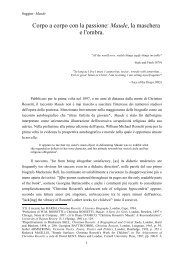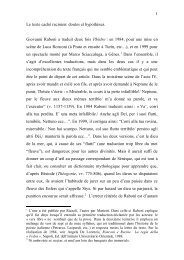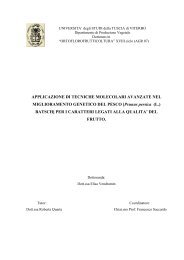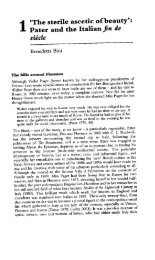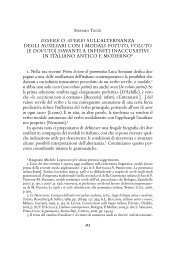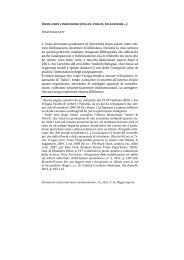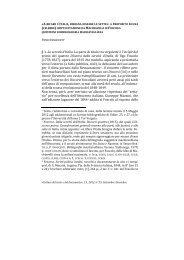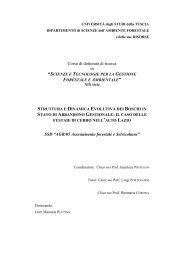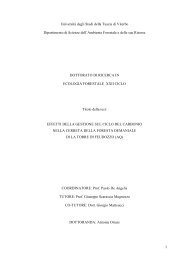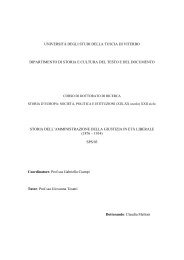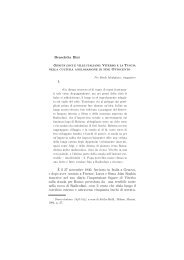drivers of soil respiration of root and microbial ... - Unitus DSpace
drivers of soil respiration of root and microbial ... - Unitus DSpace
drivers of soil respiration of root and microbial ... - Unitus DSpace
Create successful ePaper yourself
Turn your PDF publications into a flip-book with our unique Google optimized e-Paper software.
introduction in a small <strong>soil</strong> sample without plant residues <strong>and</strong> then the final k could be calculated<br />
using a proportion between the <strong>soil</strong> weight <strong>and</strong> the weight <strong>of</strong> the plant residues in the monolith<br />
(Larionova et al., 2006):<br />
160<br />
k= (R2sms+R2rsmrs)/(R1sms+R1rsmrs)<br />
where, R1s <strong>and</strong> R2s are the <strong>respiration</strong> response <strong>of</strong> the <strong>soil</strong> prior <strong>and</strong> after the glucose addition<br />
respectively; R1rs <strong>and</strong> R2rs are the <strong>respiration</strong> response as a result <strong>of</strong> decomposition <strong>of</strong> plant residues<br />
prior <strong>and</strong> after the glucose addition <strong>and</strong> ms <strong>and</strong> mrs are the masses <strong>of</strong> <strong>soil</strong> <strong>and</strong> plant residues in the<br />
monolith. This however, couldn’ t be done in the field <strong>and</strong> implies a k determination in the<br />
laboratory.<br />
Another shortcoming <strong>of</strong> the method is a possible boosting <strong>of</strong> <strong>root</strong> <strong>respiration</strong> after the<br />
addition <strong>of</strong> glucose in water solution, which could be especially true under insufficient <strong>soil</strong> moisture<br />
conditions. This could result in further overestimation <strong>of</strong> <strong>microbial</strong> component <strong>of</strong> <strong>soil</strong> <strong>respiration</strong>.<br />
The glucose solution was always added in the way not to exceed the 60% <strong>of</strong> the <strong>soil</strong> water capacity,<br />
we were also measuring the effect <strong>of</strong> only water on total <strong>soil</strong> <strong>respiration</strong> rates. As could be seen<br />
from the figure 4, the main effect <strong>of</strong> water occurred during the first hour after the start <strong>of</strong> the<br />
treatment with the further stabilization <strong>of</strong> the <strong>respiration</strong> rate at the initial level. The effect was<br />
longer <strong>and</strong> more pronounced in July, under the limited natural <strong>soil</strong> content (data not shown),<br />
however the <strong>soil</strong> <strong>respiration</strong> have decreased <strong>and</strong> stabilized after 5 hours <strong>of</strong> experiment, when the<br />
glucose treatment on the contrary just reached its peak.<br />
6.4.3. Regression analyses technique<br />
Although regression technique was nominated in the recent review <strong>of</strong> partitioning methods<br />
(Kuzyakov, 2006) as the most universal one due to its low cost, applicability to a wide range <strong>of</strong><br />
ecosystems <strong>and</strong> the absence <strong>of</strong> the <strong>soil</strong> disturbance, its application in this study on a grassl<strong>and</strong><br />
community showed contrasting results.<br />
The main problem we faced with regression analyses was the absence <strong>of</strong> significant<br />
correlation between the <strong>root</strong> biomass <strong>and</strong> <strong>soil</strong> CO2 efflux. The correlation was weak for the<br />
biomass sampling day <strong>and</strong> the measurement days adjacent to the day <strong>of</strong> the biomass sampling, no<br />
correlation was observed further. Despite this fact, the method managed to detect some particular<br />
changes in the contribution <strong>of</strong> <strong>root</strong> <strong>and</strong> <strong>microbial</strong> <strong>respiration</strong>, which were observed also by the mesh<br />
exclusion technique (ex.: Fig. 9, peaks in <strong>root</strong> <strong>respiration</strong> in July). This could indicate that the<br />
augment <strong>of</strong> the measurement points may improve the correlation strength.<br />
The particularity <strong>of</strong> the grassl<strong>and</strong> ecosystems is that the most <strong>of</strong> the belowground biomass is<br />
represented by the fine <strong>root</strong>s. Larionova et al.(2006) showed that fine <strong>root</strong> biomass is characterized<br />
by a greater variation in <strong>root</strong> specific activity, ranging from 0.2-1.2 mg C-CO2/g <strong>root</strong> while the




